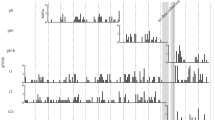Abstract
This paper analyzes allogrooming (social grooming) data collected from two large, fully integrated and long established social groups of macaques (one of pigtail macaques and one of bonnet macaques). The data demonstrates a species and sex difference for total allogrooming given with females of both species giving more grooming than the males and with pigtails as a species giving more grooming than bonnets. Also, pigtail females gave more allogrooming to clan members than to nonclan members, but this was not true for pigtail males, bonnet males, and bonnet females. Allogrooming given and allogrooming received by age class for both species showed development of a sexual dichotomy at three to four years. The analysis characterized some of the social structures extant in two closely related species of macaque, particularly the somewhat different use of allogrooming in pigtail females as opposed to the other three categories of animals. Social implications with relation to macaque societies are discussed.
Similar content being viewed by others
References
Anthony, T. R., 1968. The ontogeny of greeting, grooming, and sexual motor patterns in captive baboons (superspeciesPapio cyanocephalus),Behaviour, 31: 358–372.
Bernstein, I. S., 1970. Activity patterns in pigtail monkey groups.Folia primat., 12(3): 187–198.
Carpenter, C. R., 1964. Naturalistic behavior of nonhuman primates. The Pennsylvania State University Press, University Park, Pa.
Defler, T. R., 1976. An analysis of grooming in two species of macaque (Macaca nemestrina andMacaca radiata). PhD Thesis, University of Colorado, U.S.A.
Fitzgerald, A., 1935. Rearing marmosets in captivity.J. of Mammalogy, 16: 181–188.
Hall, K. R. &I. DeVore, 1965. Baboon social behavior. In:Primate Behavior,I. DeVore (ed.), Holt, Rinehart, & Winston, New York, pp. 53–110.
Hausfater, C., 1972. Intergroup behavior of free-ranging rhesus monkeys (Macaca mulatta).Folia primat., 18: 78–107.
Jensen, G. D., R. A. Bobbit, & B. N. Gordon, 1971. Dominance testing of infant pigtailed monkeys reared in different laboratory environments. In:Proceedings of the 3rd International Congress of Primatology, Zurich, 1970.
Kaufman, I. C., 1971. The role of ontogeny in the establishment of species specific patterns. Paper read at ARNMD Meeting, New York City, December 4, 1971.
————, 1965. The waning of the mother-infant bond in two species of macaques. In:Determinants of Infant Behavior,B. B. Foss (ed.), Ciba Foundation, London.
————, 1966. A behavioral taxonomy forMacaca nemestrina andMacaca radiata: based on longitudinal observation of family groups in the laboratory.Primates, 7: 205–258.
Koford, C. B., 1963. Rank of mothers and sons in bands of rhesus monkeys. SeeScience, 141: 356–357.
————, 1965. Population dynamics of rhesus monkeys on Cayo Santiago. In:Primate Behavior,I. DeVore (ed.), Holt, Rinehart, & Winston, New York, pp. 160–174.
Marler, P., 1965. Communication in monkeys and apes. In:Primate Behavior,I. DeVore (ed.), Holt, Rinehart, & Winston, New York, pp. 544–584.
Michael, R. P. &S. Herbert, 1963. Menstrual cycle influences grooming behavior and sexual activity in the rhesus monkey.Science, 140: 500–501.
Miller, N. H., I. A. Kling, &D. Dicks, 1973. Familial interactions of male rhesus monkeys in a semi-free ranging troop.Am. J. Phys. Anthrop., 38: 605–611.
Missakian, E. A., 1973. The timing of fission among free-ranging rhesus monkeys.Am. J. Phys. Anthrop., 38: 621–624.
————, 1974. Mother-offspring grooming relations in rhesus monkeys.Archives of Sexual Behavior, 3: 135–141.
Moynihan, M., 1967. Communication in New World primates. In:Primate Ethology,D. Morris (ed.), Aldine Publishing Co., Chicago, pp. 236–266.
Neville, M. K., 1972. The population structure of red howler monkeys (Alouatta seniculus) in Trinidad and Venezuela.Folia primat., 17: 56–86.
Oki, J. & Y. Maeda, 1973. Grooming as a regulator of behavior in Japanese macaques. In:Behavioral Regulators of Behavior in Primates, Bucknell University Press.
Poirer, R. E., 1970. Dominance structure of the Nilgiri langur (Presbytis johnii) of South India.Folia primat., 12: 161–186.
Rosenblum, L. A., 1971. Kinship interaction patterns in pigtail and bonnet macaques. In:Proceedings of the 3rd International Congress Primatology, Zurich, 1970.
Rosenblum, L. A. &I. C. Kaufman, 1967. Laboratory observations of early mother-infant relations in pigtail and bonnet macaques. In:Social Communications among Primates,S. A. Altmann (ed.), The University of Chicago Press, Chicago, pp. 33–41.
----Rosenblum, L. A., & ----I. C. Kaufman, &A. J. Stynes, 1964. Individual distance in two species of macaque.Animal Behaviour, 12: 338–342.
————, 1965. Some characteristics of adult social and autogrooming patterns in two species of macaque.Folia primat., 4: 438–451.
Sade, D. S., 1965. Some aspects of parent-offspring and sibling relations in a group of rhesus monkeys with a discussion of grooming.Am. J. Phys. Anthrop., 23: 1–18.
————, 1972. Sociometrics ofMacaca mulatta I. Linkages and cliques in grooming matrices.Folia primat., 18: 196–223.
Simonds, P. E., 1965. The bonnet macaque in Southern India. In:Primate Behavior,I. DeVore (ed.), Holt, Rinehart, & Winston, New York, pp. 175–196.
————, 1974.The Social Primates. Harper & Row, San Francisco & London.
Sparks, J., 1967. Allogrooming in primates. In:Primate Ethology,D. Morris (ed.), Aldine Press, Chicago.
Thompson, N. S., 1969. The motivation underlying social structure inMacaca irus.Animal Behaviour, 17: 459–467.
Watson, J. B., 1908. Imitation in monkeys.Psychological Bulletin, 5: 169–178.
Author information
Authors and Affiliations
About this article
Cite this article
Defler, T.R. Allogrooming in two species of macaque (Macaca nemestrina andMacaca radiata). Primates 19, 153–167 (1978). https://doi.org/10.1007/BF02373232
Received:
Accepted:
Issue Date:
DOI: https://doi.org/10.1007/BF02373232




